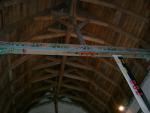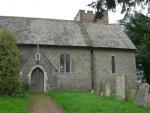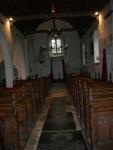Emily Rebecca Morris (1865 - 1936)
The MORRIS family and other ancestors of Emily Rebecca MORRIS
Emily Rebecca was the daughter of John MORRIS and Mary Jane ELLIS; her grandfather was also John MORRIS, as were four earlier direct ancestors, with a sole Edward appearing in the 18th century to break the sequence. They were all Kentish men born in and around Canterbury in villages such as Petham and Waltham.
An early John MORRIS, husbandman of Petham, made a will dated the 20th October 1706 and proved in 1716. This John MORRIS, who cannot with complete certainty be claimed as a direct ancestor, had a son, John, adult in 1706 when his father’s will was made and alive in 1716 when probate was granted. A possible scenario is that husbandman John MORRIS, whose wife was named Mary, had a son John whose wife was also named Mary, and this latter John and Mary were the parents of Edward MORRIS, born 1705, who married Elizabeth GOFINCH. The problem with this scenario is that John, father to Edward, seems to have died in 1716, the very year that his putative father’s will was proved. He seems to have died young because his widow lived for a further 30 years, and it may be no more than a coincidence that he died in the same year that John MORRIS’s will was proved. In time it may be possible to clarify this situation.
No such uncertainty exists with regard to the MORRIS descent from Edward, who was baptised the 9th December 1705 in Petham, son of John and Mary MORRIS. In 1729 he married Elizabeth GOFINCH in Petham, and they had eight children, all born in Petham between 1729 and 1742, including the next direct ancestor, John, who was the last of their children. This John MORRIS married Elizabeth HALKE in Petham; both single persons of the village, they were married by banns and, significantly, were sufficiently literate to sign the register
ELIZABETH HALKE
Elizabeth was one of three daughters born to William and Mary HALKE in Petham. Baptised the 27th December 1749, she married John MORRIS in December 1764 and they had up to seven children before her early death at the age of 35 in 1784. Of their seven possible children, several died young, and a baptism has not been found for the first-born, John. Interestingly, however, the will of unmarried Frances HALKE of Petham, written in November 1790 and proved in 1805, names as beneficiaries her nephews John, Thomas, and William, all sons of “her deceased sister Elizabeth”. So it can safely be assumed that John was born in another parish between 1765 and 1769 when his brother Thomas was born. The third sister Abigail, named after her aunt and grandmother, married William ELLEN with whom she had several children including Halke ELLEN, born in 1771 at Kingston, an interesting example of a maiden name preserved as a first name in the next generation.
The Halke family had been prominent in Petham, Waltham and Elmstead since Norman times and owned considerable estates in the three villages. Originally Norman ‘de Haut’, the name survives today in Hault’s Farm on the boundary of Petham and Waltham. The writer, in conversation with a local publican and his restaurant waitress who had lived her entire life in the area, established that Halke had been a local name until very recently. Both Petham (meaning ‘an enclosure in the hollow’) and Waltham (‘a settlement in the forest or weald’) are recorded in the Domesday Book, and de Haut was an important Norman family from the 12th century. A Memorial Inscription laid into the floor of Petham church commemorates Thomas HALKE Gentleman of Petham and his wife Mary and their descendants.
These 18th century MORRISES and the families with whom they intermarried were literate and made wills; we can reasonably deduce, therefore, that they owned property and were yeoman or husbandman class. That a Halke daughter was allowed to marry a Morris, and that their children benefited under the will of a maiden Halke relative, is evidence of the correctness of this assumption.
SUSAN/SUSANNAH DRURY (DREWRY) - FARLEY - PIPE
The next John MORRIS (1768-1834) married a most intriguing woman. Susanna DRURY or DREWRY, daughter of Thomas and Mary, was baptised the 5th November 1758 in Boughton under Blean; she had an older brother Thomas, baptised the 29th of February 1756 in the same parish. From her marital history she might well be known as ‘the merry widow’ or even ‘the black widow’; but we must beware, of course, imposing an interpretation on events merely because it appears to explain them.
On the face of it Susan DRURY, a 23-year old spinster of All Saints, Canterbury, married by banns Edward FARLEY of Hackington the 17th October 1782. The banns were read in the bride’s parish, while the ceremony was conducted in the groom’s; he signed the register, she made her mark. Two daughters were born of this union, Sarah FARLEY at Sturry in 1783 and Mary Anne FARLEY at Chartham in 1785, before Edward’s presumably early death between 1785 and 1792. Since his burial has not been found, we do not know when Susan was widowed or how long it took her to find another husband. Assuming that only one individual is involved, almost exactly 10 years after her first marriage Susannah FARLEY, widow of the parish of Petham, married by banns Jeremiah PIPE, bachelor of Minster but resident of Petham, the 20th May 1792 in Petham.
Both bride and groom signed the register; so either the Susan DRURY who married in 1782 is not the Susannah FARLEY who married in 1792 or, more plausibly perhaps, she had become sufficiently literate in the intervening 10 years to write her name. Interestingly, this marriage was witnessed by a John MORRIS who made his mark; since John MORRIS (1742-1821) signed the register at his own wedding, it seems likely that the illiterate witness to the marriage of Susannah FARLEY and Jeremiah PIPE was his son John (c1768-1834) who, some 18 months later, would become the third husband of Susanna DRURY/FARLEY/PIPE! Intriguing. Various juicy possibilities are suggested by this sequence of events, especially if viewed from a 20th century perspective. What actually happened in the 18th century is likely to be more mundane. People died suddenly, and they died young; the probability is that Susannah was simply unlucky in her choice of husbands. As with Edward FARLEY, a death has not been found for Jeremiah PIPE, and seemingly there was no surviving issue of this brief marriage, though a possible child was Mary PIPE, an infant buried 26 October 1793 in Petham.
Undaunted by such marital disappointments, Susannah embarked on a third marriage on the 30th of November 1793, in Petham, and apparently to the John MORRIS who witnessed her marriage to Jeremiah PIPE the previous year. Again, the marriage was by banns, both bachelor John MORRIS and widow Susannah PIPE were Petham residents, and their union was witnessed by Thomas MORRIS who signed his name. Thomas, presumably John’s brother, was possibly a second son of that name born to John MORRIS and Elizabeth HALKE. An earlier Thomas, born in 1769, probably died in 1777; but we have firm evidence from Frances HALKE’s will that a nephew Thomas was alive in 1805. No children born to John and Elizabeth have been found after 1779, but since Elizabeth lived until 1784 and was only 35 when she died, the possibility remains that other children were born in another parish.
John MORRIS was about 24 years of age when he married Susannah PIPE, while she was 35 with, apparently, two surviving daughters from her previous two marriages. Perhaps it was a case of third time lucky. John and Susannah remained married until her death, aged 73, in Petham in 1831, while John survived her only 3 years, his death at age 65 being recorded in 1834. And if Susannah had only two surviving daughters from her first two marriages, she made up for it in her third, having four children between 1794 and 1802 when she would have been 44. She and John had two sons, Thomas and John, and two daughters, Elizabeth and Fanny, in Petham, the last born being the next to bear the name of John MORRIS.









